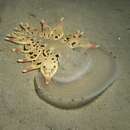pt-BR
nomes no trilho de navegação


Die Schleierschnecke (Tethys fimbria) ist eine große gehäuselose Schnecke des Mittelmeers aus der Unterordnung der Nacktkiemer, die sich schwimmend in Bodennähe fortbewegt und sich von Krebsen ernährt.
Die Schleierschnecke kann 30 cm lang werden. Ihr Körper ist stark abgeflacht und hat am Kopf einen ausgedehnten trichterförmigen Schleier (Velum), der am Rand mit zahlreichen Sinnespapillen besetzt ist. Der Kopf trägt keine Fühler, und die Rhinophoren sind klein und kegelförmig. Die Schnecke hat weder Kiefer noch Radula. Der Rücken trägt zwei Reihen einfacher blattförmiger Fortsätze, die leicht abfallen (Autotomie) und sich dann noch eine Weile bewegen. So können sie Feinde ablenken. Neben jedem Fortsatz am Rücken befinden sich Kiemen. Die Schnecke ist durchscheinend und hat auf den Rückenfortsätzen sowie manchmal am Rand des Fußes und des Schleiers schwarze Flecken.
Die Schleierschnecke lebt im Mittelmeer und an der afrikanischen und europäischen Küste des Atlantischen Ozeans von Portugal bis zum Golf von Guinea.
Ruhend bevorzugt die Schleierschnecke sandiges oder schlammiges Substrat in Tiefen von 20 bis 150 Metern. Sie bewegt sich frei schwimmend fort.
Die Schleierschnecke ernährt sich von kleinen Krebsen, die sie mit ihrem Schleier einfängt.
Carl von Linné beschrieb 1758 in der 10. Auflage seines Systema Naturae eine Gattung Tethys mit den beiden Arten Tethys limacina und Tethys leporina.[1] Während er für die erste Art keine Quellen aufführt, nennt er für die zweite Art als erste Quelle Guilelmus Rondeletius, in dessen Werk Libri de Piscibus Marinis von 1554 auf einem Bild ein Seehase, offensichtlich der Art Aplysia fasciata abgebildet ist.[2] In der 12. Auflage des Systema Naturae folgt 1767 eine gänzlich andere Beschreibung für denselben Gattungsnamen, wobei diesmal die Artnamen Tethys leporina und Tethys fimbria aufgeführt werden. Linnaeus bezieht sich hier auf die 1761 von Johann Baptist Bohadsch abgebildete Fimbria[3] und weitere Quellen, durch die beide beschriebenen Arten als Schleierschnecke identifizierbar sind, während das Bild von Rondeletius nunmehr die Gattung Laplysia beschreibt, an vorheriger Stelle im selben Werk Aplysia genannt.[4] Linnés Beschreibungen von 1767 bildeten die Grundlage für die spätere und bis heute gültige Verwendung der Gattungsnamen Tethys und Aplysia, obwohl es auch Vorschläge gegeben hat, sich an die Erstveröffentlichung zu halten. Der Name Tethys limacina lässt sich jedoch zu keiner Tierart eindeutig zuordnen und ist somit ein zweifelhafter Name.[5] 1954 wurden von der Internationalen Kommission für Zoologische Nomenklatur Linnés Beschreibungen von 1767 als gültig festgelegt, obwohl die dem widersprechenden Beschreibungen von 1758 älter sind. Somit blieben die eingebürgerten wissenschaftlichen Namen erhalten. Für die Schleierschnecke ist Tethys fimbria der gültige Name und Tethys leporina ein Synonym.[6] 1981 ist der Name der Familie auf Tethydidae (mit d) festgelegt worden, um sie von den Schwämmen der Familie Tethyidae (Typusgattung Tethya) zu unterscheiden, während der Gattungsname der Seescheiden Tethyus nunmehr ungültig ist.[7]
Die Schleierschnecke (Tethys fimbria) ist eine große gehäuselose Schnecke des Mittelmeers aus der Unterordnung der Nacktkiemer, die sich schwimmend in Bodennähe fortbewegt und sich von Krebsen ernährt.
Tethys fimbria is a species of predatory sea slug, a nudibranch, a marine gastropod mollusk in the family Tethydidae.
ICZN opinion 200 ruled that Tethys fimbria is a valid name and Tethys leporina Linnaeus, 1758 is a synonym.[2]
The distribution of Tethys fimbria includes the Mediterranean Sea and the east coast of the Atlantic Ocean from Portugal in the north, to the Gulf of Guinea in the south.[3]
The length of the body of Tethys fimbria can reach up to 30 cm (12 in).[3] Tethys fimbria is translucent, but it has dark spots on its cerata.[3] It has a broad oral hood in the frontal part of its body.[3] Rhinophores are small.[3] Tethys fimbria has no radula as is the case in all members of the family Tethydidae.[3]

The habitat of Tethys fimbria is seas which have sand or mud on the bottom, in depths from 20 to 150 m.[3]
Tethys fimbria captures and feeds on small crustaceans.[3] It uses its broad hood for catching them.[3]
The cerata can be self-amputated (autotomy) as a defence mechanism when the slug is in danger.[3]
Within the mantle large amounts of prostaglandins are produced.[4] Subsequently the prostoglandins are moved to the cerata.[4] The biosynthesis of prostgandins has been studied by Marzo et al. (1991).[4]
Tethys fimbria is a species of predatory sea slug, a nudibranch, a marine gastropod mollusk in the family Tethydidae.
ICZN opinion 200 ruled that Tethys fimbria is a valid name and Tethys leporina Linnaeus, 1758 is a synonym.
Tethys fimbria Linnaeus, 1767 è un mollusco nudibranco appartenente alla famiglia Tethydidae.[1]
È il più grande tra i nudibranchi mediterranei, fino a 30 centimetri.
Come per la ballerina spagnola può nuotare tramite ondulazioni del corpo e dei cerata, modificati, che vengono chiamati fenicura.
Si nutre di crostacei ed echinodermi.
È diffusa nel mar Mediterraneo e nell'oceano Atlantico orientale, su fondali fangosi o sabbiosi, tra 20 e 150 metri di profondità. Un esemplare è stato avvistato anche davanti alla costa di Riccione, un avvistamento insolito per le acque del mar Adriatico. A distanza di un mese dal primo avvistamento, un altro raro esemplare, sembrerebbe in età giovanile è stato avvistato e fotografato nel nord Adriatico tra Portopiccolo e il golfo di Sistiana a pochi metri dalla riva.
Tethys fimbria Linnaeus, 1767 è un mollusco nudibranco appartenente alla famiglia Tethydidae.
Tethys fimbria is een slakkensoort uit de familie van de Tethydidae.[1] De wetenschappelijke naam van de soort is voor het eerst geldig gepubliceerd in 1767 door Linnaeus.
Bronnen, noten en/of referentiesTethys fimbria é uma espécie de molusco pertencente à família Tethydidae.
A autoridade científica da espécie é Linnaeus, tendo sido descrita no ano de 1767.
Trata-se de uma espécie presente no território português, incluindo a zona económica exclusiva.
Tethys fimbria é uma espécie de molusco pertencente à família Tethydidae.
A autoridade científica da espécie é Linnaeus, tendo sido descrita no ano de 1767.
Trata-se de uma espécie presente no território português, incluindo a zona económica exclusiva.